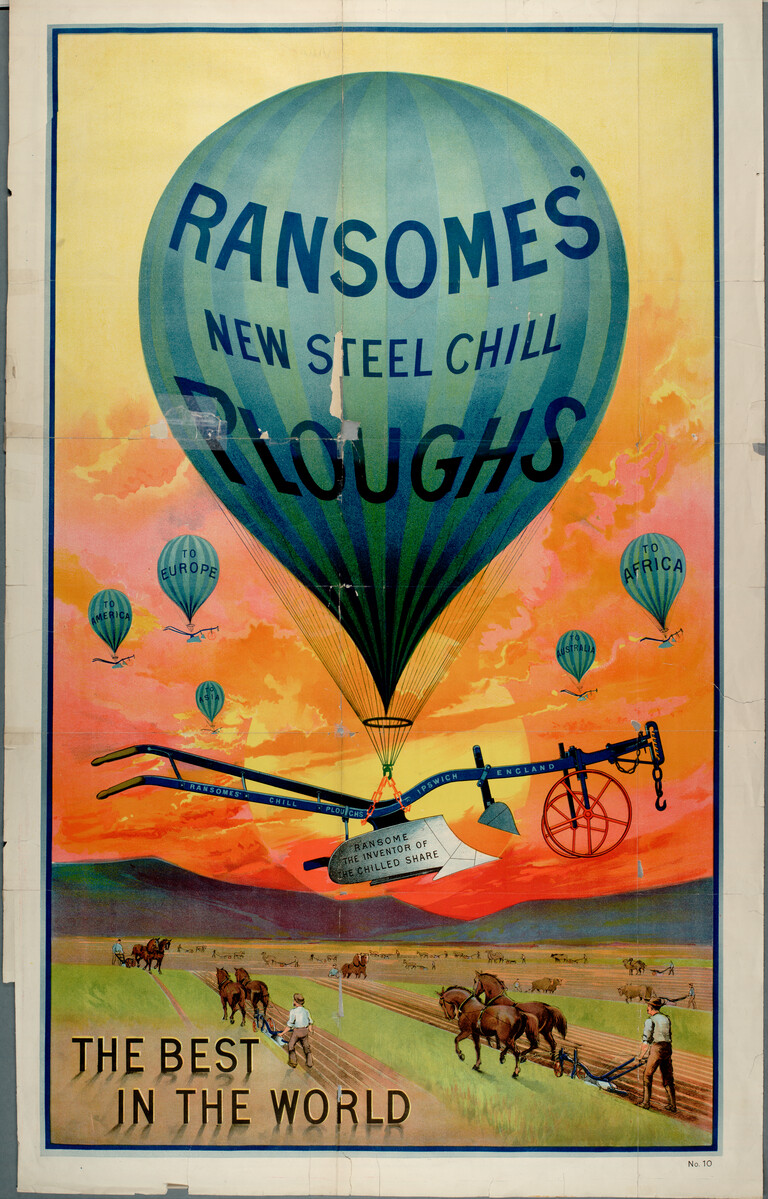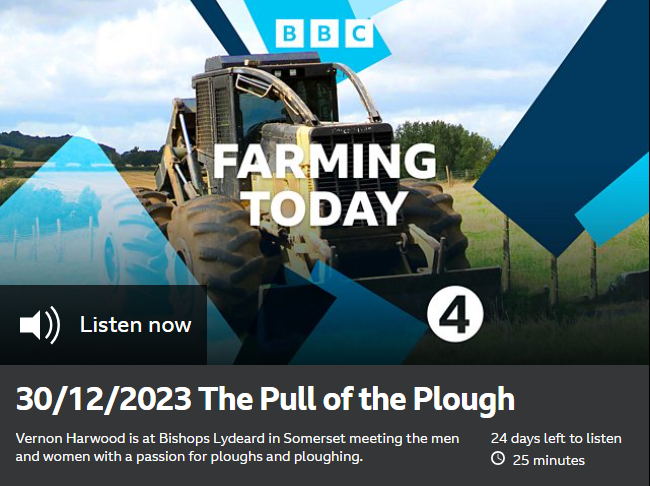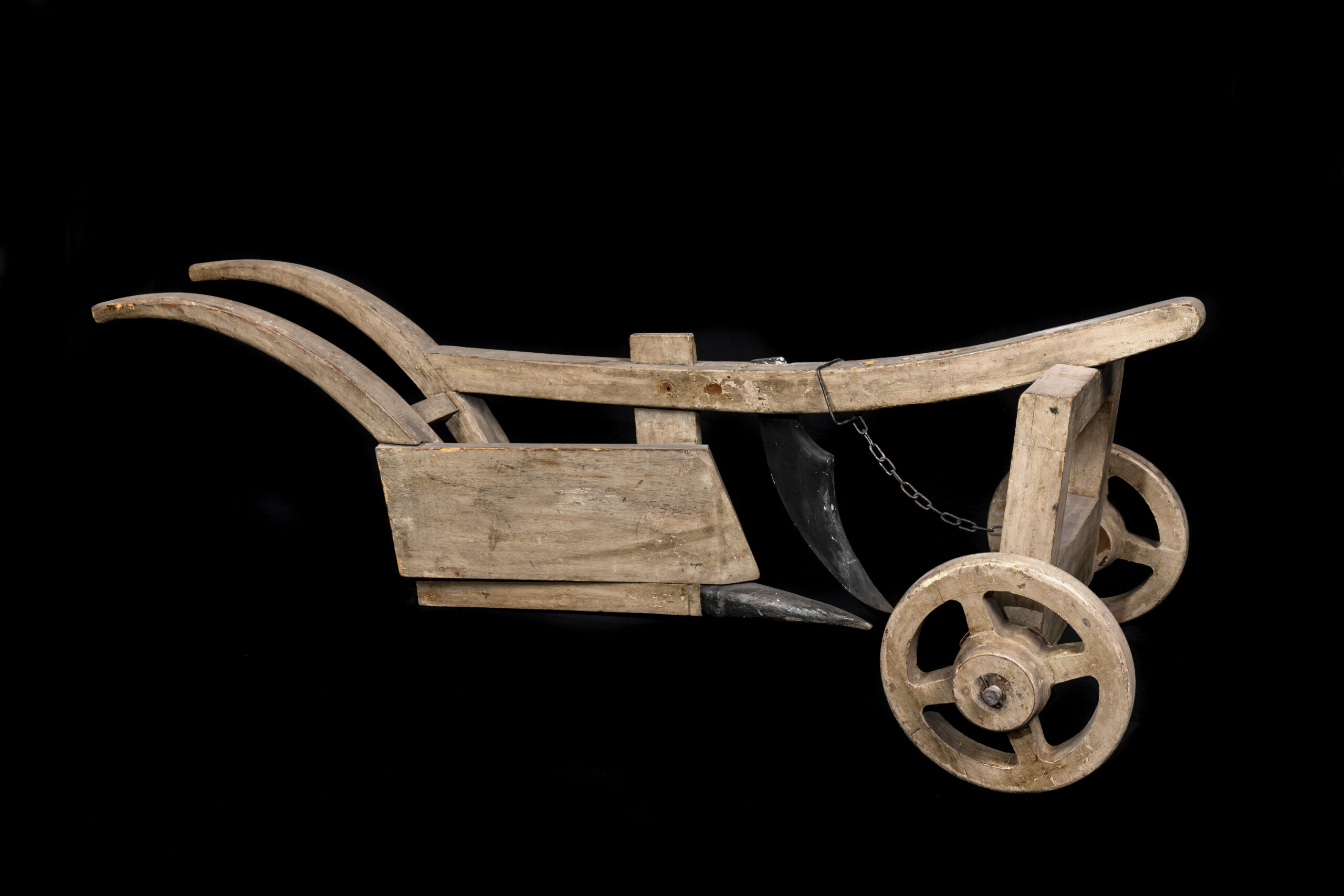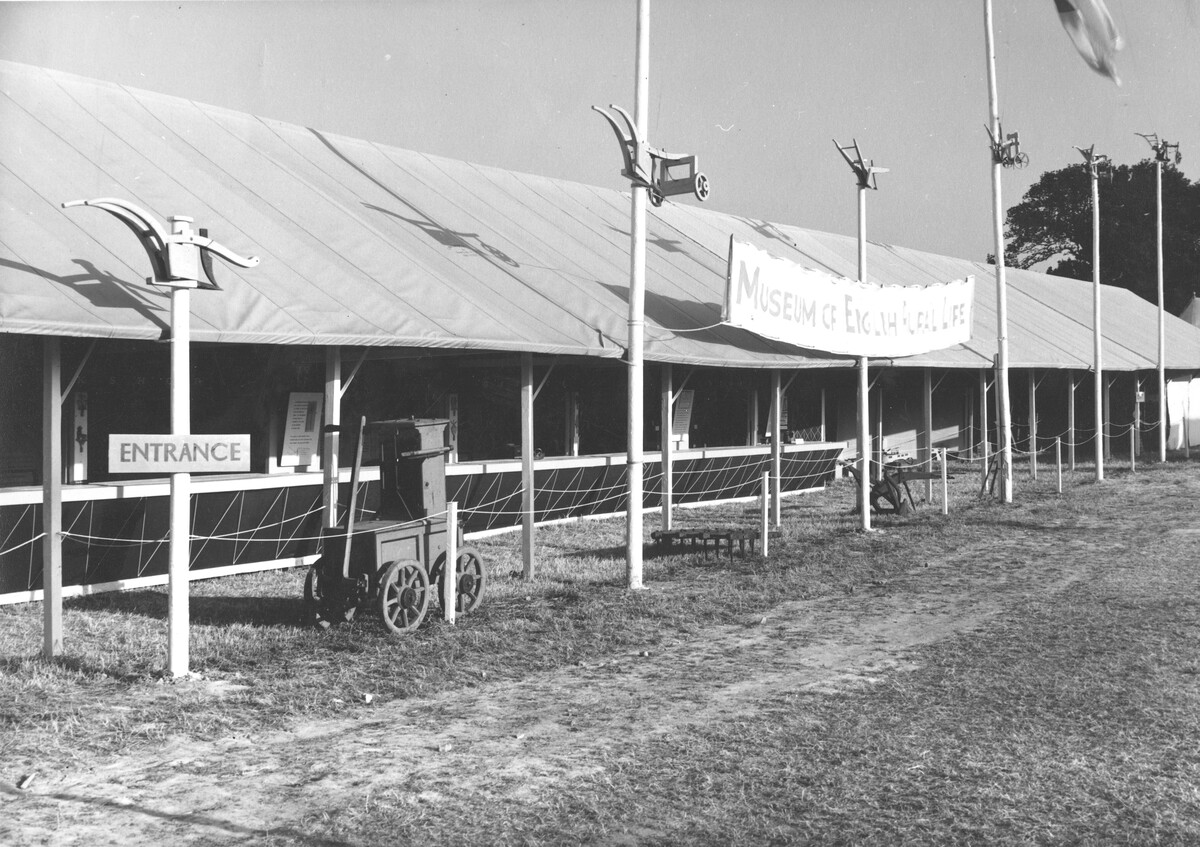Ploughs and Ploughing: some reflections from the headland
MERL Curator, Ollie Douglas, shares his thoughts on ploughing and the MERL's plough collection

For Plough Monday this year, we’ve allowed Curator of MERL Collections Dr Ollie Douglas the opportunity to wax lyrical about his personal interest in ploughing and the Museum’s celebrated collection of ploughs, following an appearance on a special ploughing edition of Radio 4’s ‘Farming Today’ programme on December 30th. Bear with him as he brings together his thoughts on the subject and digs up (pun intended) what turns out to be quite a lot of previous musings on the subject.
When I mentioned to my siblings that they could tune in to Farming Today on BBC Radio 4 to hear a snippet of me talking about plough collections, they were amused by a short caption that described ‘men and women with a passion for ploughing’. We grew up on a mixed farm where ploughing was undoubtedly part of everyday life. However, as evidenced by a career spent keeping old ploughs at a far remove from actual fields, keen as I am on the countryside I have never been proactive about engaging in the hard labour of farm work. It is fair to say that I am passionate about farm heritage and its role in shaping our lives. But perhaps the time has come to admit that I am less keen on the prospect of getting out in the wind and rain to prepare the ground in the Spring.
Back on the family farm I remember watching my brother learn how to drive a tractor and then get pressured into hours at the wheel, practicing and honing his fledgling skills by traversing fields with the plough. My refusal to follow his lead was perhaps my first step towards the curatorial job I now hold. Rather than sitting myself in the driving seat, I see my role more as one of celebrating the endeavours of others and helping to share and explain their efforts and experiences more widely. Yes, it may be the culmination of a lifelong effort to avoid hard work (apologies here to my lovely, long-suffering colleagues!) but this laziness is also a means for me to excuse standing back from the furrow so I can look at everything that’s going on. The curator’s gaze is very different to that of the ploughman, neither following the horse nor staring back behind the tractor, but instead looking carefully on from the ‘end rig’ or ‘headland’ where the plough turns. Less a participant and more an observer.
It was in this space that I spoke to Radio 4’s Vernon Harwood, sharing recollections of plough specialists and connoisseurs, of rural writer H. J. Massingham’s efforts to find a plough for his interwar collection of country relics and his eventual acquisition of an unusual wooden mouldboard (the part of a plough that turns the soil over) from Stadhampton. This is the small Oxfordshire village where my mother grew up. One of the ploughs on display in this gallery was used at the World Ploughing Championships at Shillingford in 1956, just a few miles as the crow flies from my mother’s childhood home. The MERL had a stand at this event and my grandfather also took mum along, excusing her from school for the day to see, as she has since put it, ‘lots of farmers in flat caps looking at ploughs.’

From here we segue to the powerful story of farmer and cheesemaker, Charles Martell, and his quest to chart the history of the Gloucestershire Long Plough. Charles has also been at The MERL, examining these same collections with his expert eye. Vernon and I talked about Charles and the surviving examples he has sought out of this iconic early form of plough, of how it relates to the wooden mouldboard from Stadhampton, and of a mysterious missing example that I once saw in the stores of another major museum. But I’ll leave that mystery plough and its story for another day.
The broadcast was only able to accommodate a little of our fascinating and passionate discussions, hence in part why it feels worth noting them here. The wider piece examined the expansive cultural appeal of ploughs and the many ways in which they have been venerated and celebrated through competitive ploughing matches, religious connections, calendar customs, and in popular campaigns over hundreds if not thousands of years. For example, the custom of Plough Monday marks a return to labour in the post-Christmas period. Whilst my return comprises sitting back at my keyboard, a return to the fields and the business of farming is something that still resonates in many in the rural communities of the UK. There is a potent nostalgia to these iconic pieces of farm machinery too. Indeed, through the images and words of ‘plough up’ campaigns of the early-1940s ploughs became synonymous with the push for wartime food security. In the post-war era, as the Green Revolution took hold in farming, plough technologies continued to play a part in constructing compelling narratives of progress.
The development and improvement of ploughs and related technologies has been endlessly told and retold, such as through the cul-de-sac story of the late-nineteenth century steam ploughing era, or model ploughs displayed at the 1951 Festival of Britain. The MERL itself repurposed those same models in 1952 at the Royal Agricultural Show, and two of them are on display in our latest Model Farming gallery, confirming the ongoing place of the plough in the ever-changing story of English rural life. But in more recent decades ploughs have also begun to play a different role, as signs of the problems that came hand in hand with post-war changes to farming practice, and as potential barriers to soil health and environmental recovery. In the latest language of regenerative farming, ‘low till’ and ‘no till’ have begun to push this age-old technology to those same end rigs where slothful, watchful curators like me stand idle, always ready to consign another outmoded machine to the archive.
Image 1: The Museum’s stand at the Royal Agricultural Show in 1952, which featured scale models of ploughs from the Festival of Britain displayed prominently on poles (MERL D/MERL).
Image 2: This scale model of a seventeenth century plough was first displayed at the Festival of Britain in 1951, and later used on the Museum’s trade stand at the Royal Agricultural Show in 1952 (MERL 52/68).
The United Nations might now operate under a banner of ‘peace, dignity and equality on a healthy planet’ but in the past it past borrowed from the potent biblical imagery and message of turning ‘swords into ploughshares’. This notion was of such importance that we find it repeated in Isaiah, Micah, and Joel. The same sentiment even adorns a vintage Oxfam tea towel that I have on my wall at home:
‘And they shall beat their swords into ploughshares // And their spears into pruning hooks/ And they shall sit everyman under his vine and under his fig tree / And none shall make them afraid.’
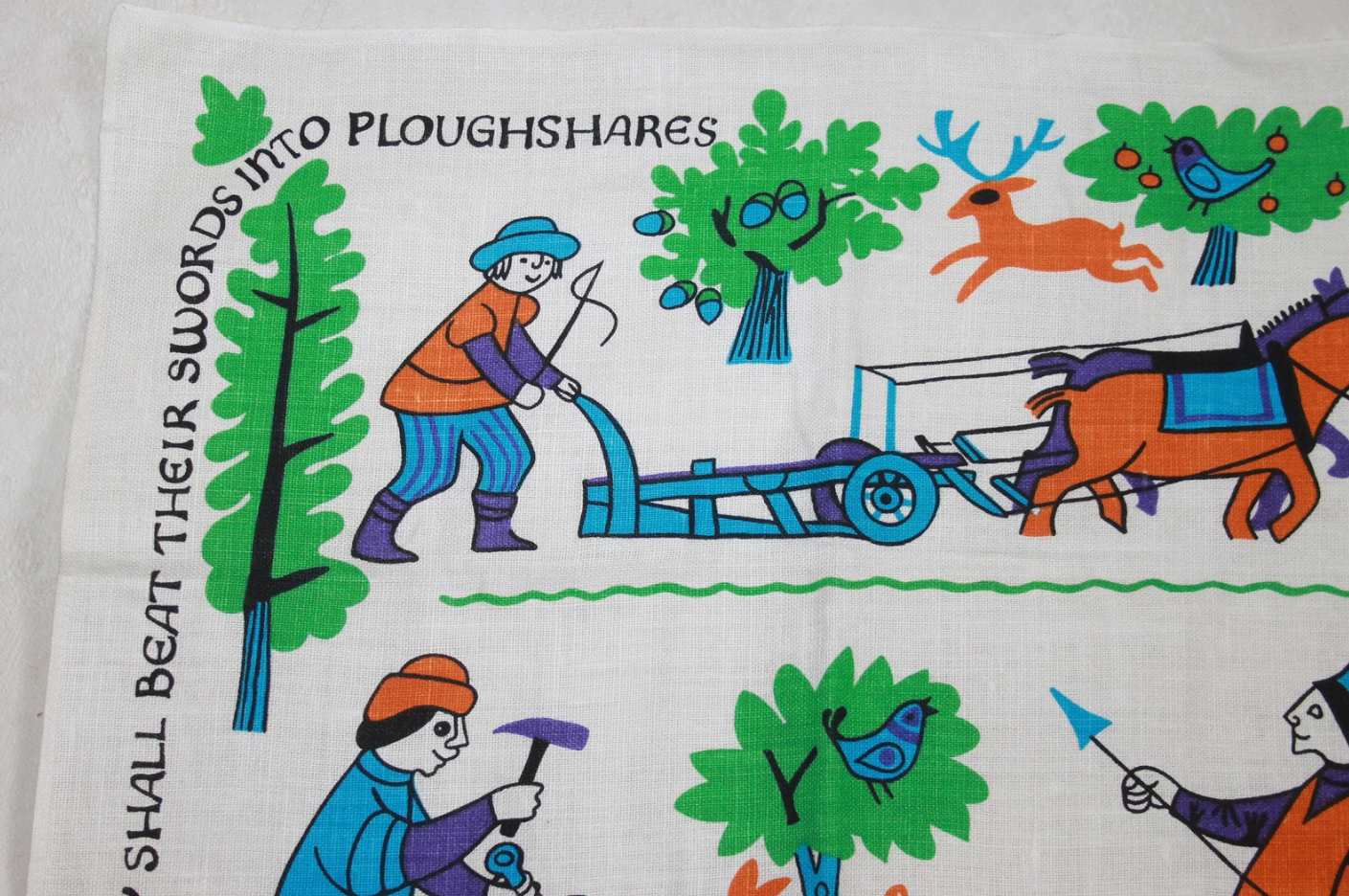
With terrible conflicts still underway in Ukraine’s ‘bread basket of Europe’ and in Gaza, part of the ‘fertile crescent’ where such tilling practices first emerged, the sentiment of thinking about basic human needs first feels just as important today. Ploughs are clearly not the answer to peace and reconciliation. The upended sculpture of a redundant tractor plough at the Groundswell regenerative farming festival serves as a powerful symbol of the plough and its part in harmful farming practices and even in colonial impositions of global northern farming in the global south. However, in spite of the arguably outmoded nature of this ubiquitous farm technology perhaps the plough and its image can still serve as a symbol of some important shared global challenges, to feed our growing global population and to live in greater harmony with the scarce and precious resources of the planet.
